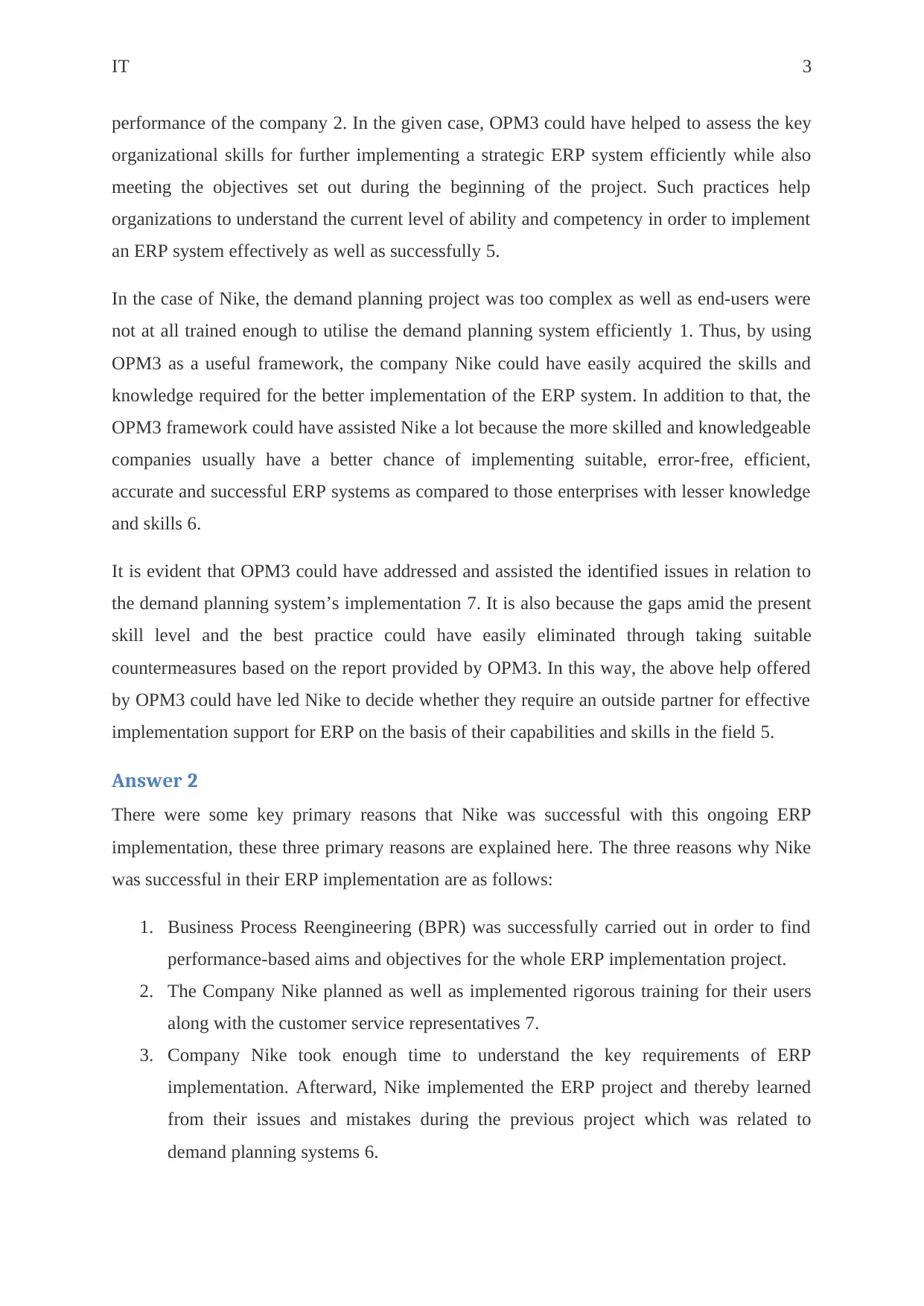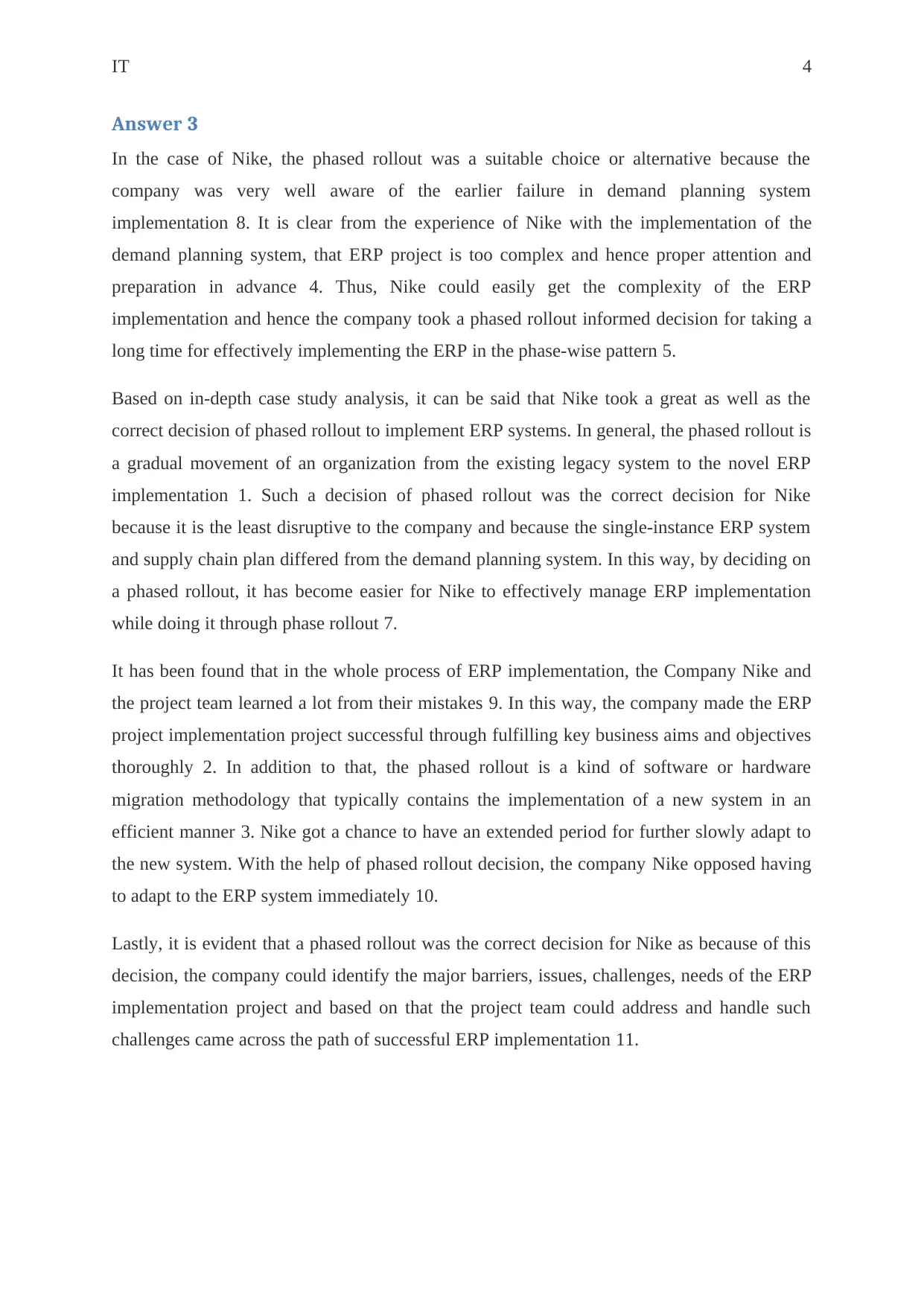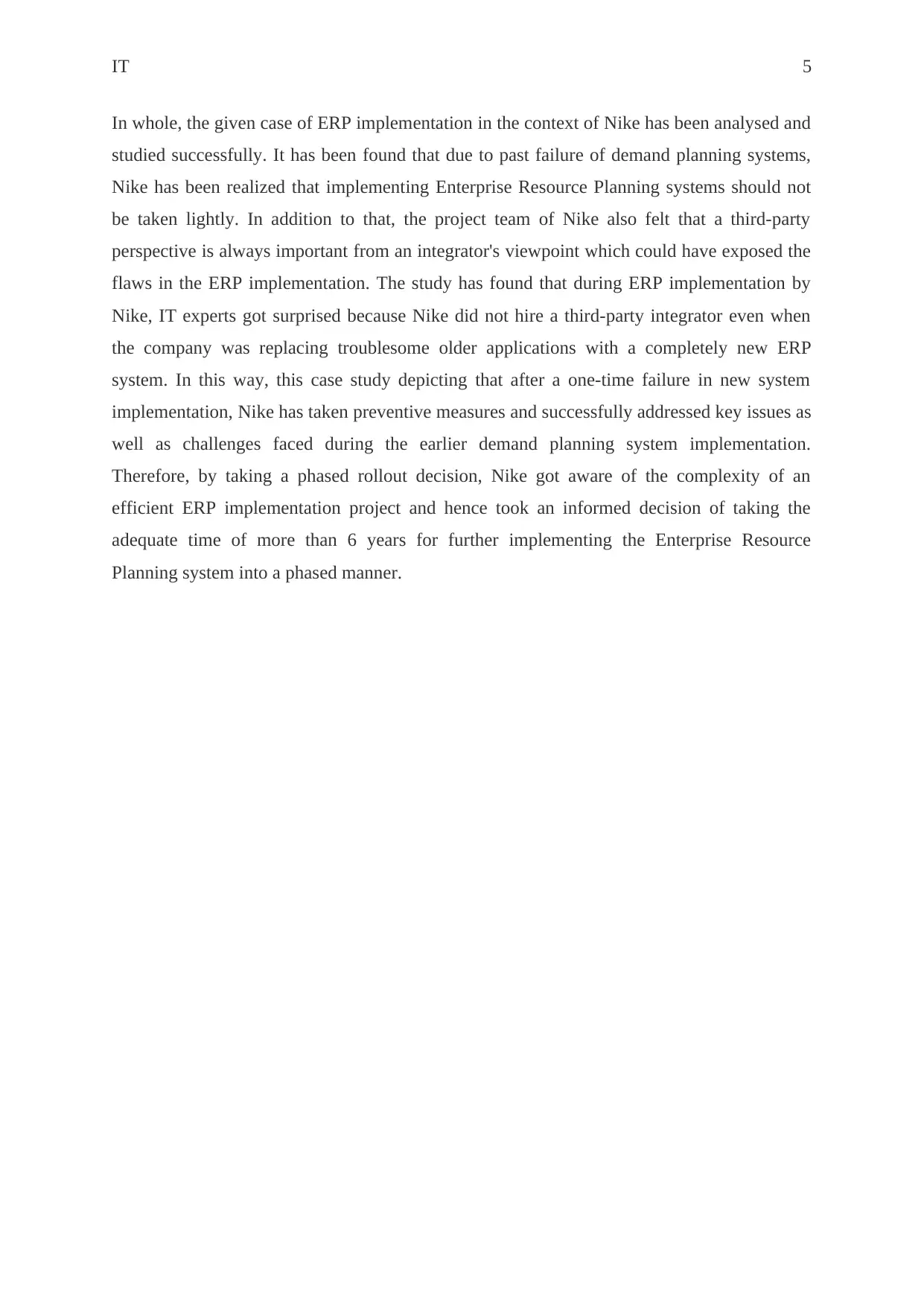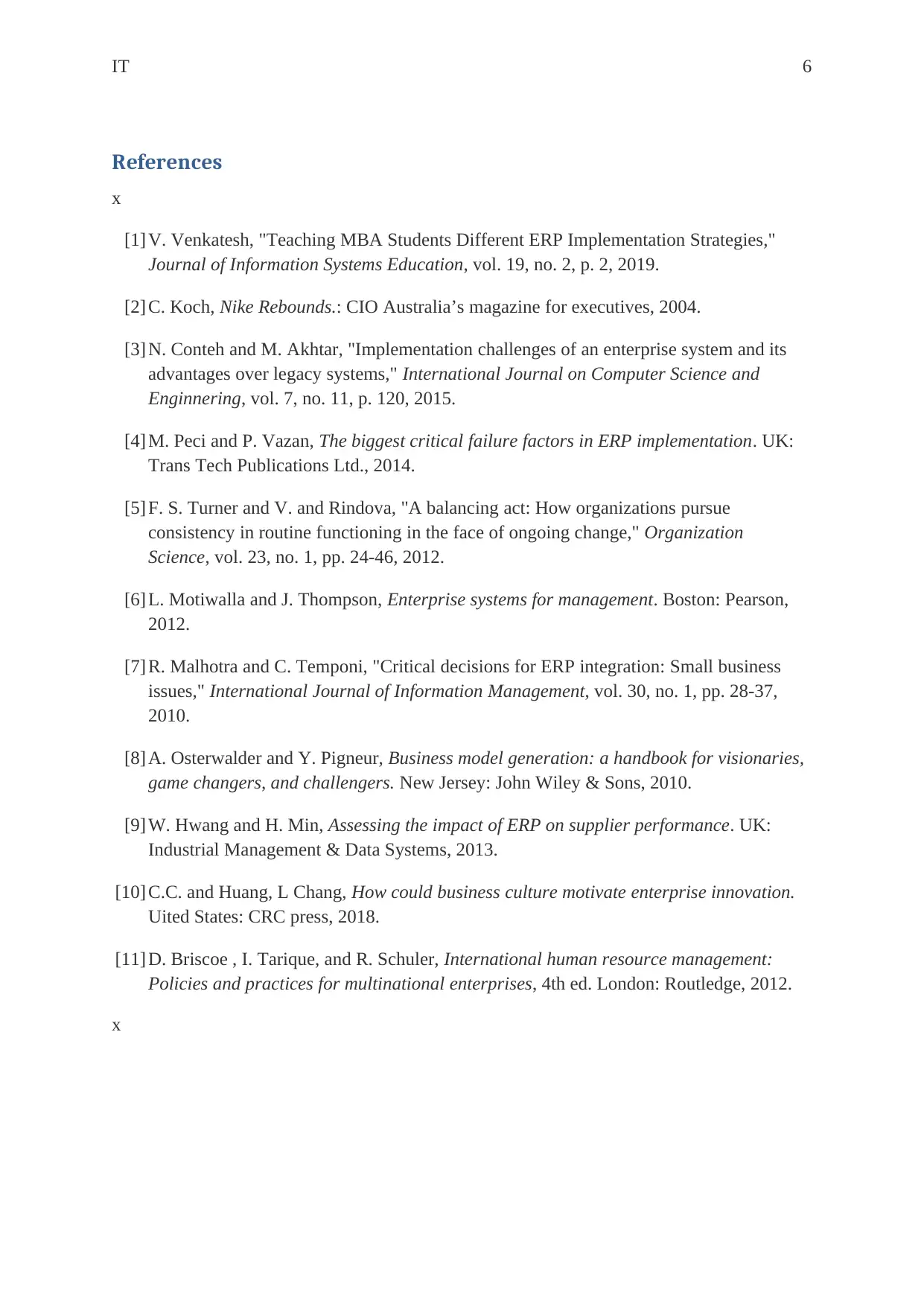MITS6004 Assignment 1: Nike ERP Implementation Case Study Analysis
VerifiedAdded on 2022/09/09
|7
|1893
|80
Case Study
AI Summary
This case study analyzes Nike's Enterprise Resource Planning (ERP) implementation, examining the challenges and successes encountered during the process. The analysis delves into the application of the OPM3 framework, business process reengineering (BPR), and the decision to adopt a phased rollout approach. The study highlights the importance of thorough preparation, user training, and understanding business requirements for successful ERP implementation. It discusses the lessons learned from the demand planning system failure and how Nike addressed the complexities of ERP projects. The case study emphasizes the significance of a third-party perspective and the benefits of a phased rollout for managing ERP implementation effectively. The analysis covers the factors that contributed to Nike's successful ERP implementation, including the identification of key business aims and objectives. The study concludes by underscoring the importance of learning from past mistakes and making informed decisions when implementing ERP systems.

Running Head: IT
0
Enterprise Resource Planning
Nike case study
(Student Details: )
4/2/2020
0
Enterprise Resource Planning
Nike case study
(Student Details: )
4/2/2020
Paraphrase This Document
Need a fresh take? Get an instant paraphrase of this document with our AI Paraphraser

IT 1
Contents
Case Study: Nike ERP Implementation.....................................................................................2
Case Study Analysis...............................................................................................................2
Answer 1................................................................................................................................2
Answer 2................................................................................................................................3
Answer 3................................................................................................................................4
References..................................................................................................................................6
Contents
Case Study: Nike ERP Implementation.....................................................................................2
Case Study Analysis...............................................................................................................2
Answer 1................................................................................................................................2
Answer 2................................................................................................................................3
Answer 3................................................................................................................................4
References..................................................................................................................................6

IT 2
Case Study: Nike ERP Implementation
This discussion is focused on the case study analysis of “Nike ERP Implementation. In this
context, the case study analysis is designed to analyse enterprise activities as well as to
identify key issues, weaknesses, strengths, threats, and entities while interacting with the
other enterprise. The discussion is going to demonstrate an application of knowledge for
further identifying and making recommendations in order to devise solutions for an ERP
implementation in the context of Enterprise Platform like Nike 1.
Nike is a well-renowned company inside the field of producing sports shoes for football,
athletics, volleyball and many others. This 1957 based organization started production the
health and sports equipment in additional product categories. The employer follows the
assignment to constantly innovate the sports products as per consistent with the worldwide
requirements 2. In 2000, the company determined to forecast the demand of the marketplace
demands so that it may manipulate the implementation of the supply chain management as in
keeping with according to its purchaser necessities 2.
Case Study Analysis
Answer 1
In this context, the OPM3 refers to a framework which can be used by the modern
organizations for evaluating the level of capability as well as skills to further implement the
Enterprise Resource Planning (ERP) systems as per the needs at the beginning of the whole
enterprise project in the baseline of time and budget as well 3. In the context of a given case
of Nike ERP implementation, (OPM3) could have helped to identify the problems with
implementing the demand planning system because by using OPM3 as a framework, Nike
could have easily acquired the useful knowledge in relation to the system implementation
best practices even at the initial stage of the assessment 4. Afterward, the actual assessment
could have followed on the basis of the current skill level for the whole demand planning
system project 3.
It is worth knowing that OPM3 typically offers a methodology for organizations in order to
understand the OPM practices as well as to make such processes able to performing
consistently, predictably and successfully 4. It has been found that OPM3 always helps
enterprises like Nike developing a roadmap which can be used to enhance the overall
Case Study: Nike ERP Implementation
This discussion is focused on the case study analysis of “Nike ERP Implementation. In this
context, the case study analysis is designed to analyse enterprise activities as well as to
identify key issues, weaknesses, strengths, threats, and entities while interacting with the
other enterprise. The discussion is going to demonstrate an application of knowledge for
further identifying and making recommendations in order to devise solutions for an ERP
implementation in the context of Enterprise Platform like Nike 1.
Nike is a well-renowned company inside the field of producing sports shoes for football,
athletics, volleyball and many others. This 1957 based organization started production the
health and sports equipment in additional product categories. The employer follows the
assignment to constantly innovate the sports products as per consistent with the worldwide
requirements 2. In 2000, the company determined to forecast the demand of the marketplace
demands so that it may manipulate the implementation of the supply chain management as in
keeping with according to its purchaser necessities 2.
Case Study Analysis
Answer 1
In this context, the OPM3 refers to a framework which can be used by the modern
organizations for evaluating the level of capability as well as skills to further implement the
Enterprise Resource Planning (ERP) systems as per the needs at the beginning of the whole
enterprise project in the baseline of time and budget as well 3. In the context of a given case
of Nike ERP implementation, (OPM3) could have helped to identify the problems with
implementing the demand planning system because by using OPM3 as a framework, Nike
could have easily acquired the useful knowledge in relation to the system implementation
best practices even at the initial stage of the assessment 4. Afterward, the actual assessment
could have followed on the basis of the current skill level for the whole demand planning
system project 3.
It is worth knowing that OPM3 typically offers a methodology for organizations in order to
understand the OPM practices as well as to make such processes able to performing
consistently, predictably and successfully 4. It has been found that OPM3 always helps
enterprises like Nike developing a roadmap which can be used to enhance the overall
⊘ This is a preview!⊘
Do you want full access?
Subscribe today to unlock all pages.

Trusted by 1+ million students worldwide

IT 3
performance of the company 2. In the given case, OPM3 could have helped to assess the key
organizational skills for further implementing a strategic ERP system efficiently while also
meeting the objectives set out during the beginning of the project. Such practices help
organizations to understand the current level of ability and competency in order to implement
an ERP system effectively as well as successfully 5.
In the case of Nike, the demand planning project was too complex as well as end-users were
not at all trained enough to utilise the demand planning system efficiently 1. Thus, by using
OPM3 as a useful framework, the company Nike could have easily acquired the skills and
knowledge required for the better implementation of the ERP system. In addition to that, the
OPM3 framework could have assisted Nike a lot because the more skilled and knowledgeable
companies usually have a better chance of implementing suitable, error-free, efficient,
accurate and successful ERP systems as compared to those enterprises with lesser knowledge
and skills 6.
It is evident that OPM3 could have addressed and assisted the identified issues in relation to
the demand planning system’s implementation 7. It is also because the gaps amid the present
skill level and the best practice could have easily eliminated through taking suitable
countermeasures based on the report provided by OPM3. In this way, the above help offered
by OPM3 could have led Nike to decide whether they require an outside partner for effective
implementation support for ERP on the basis of their capabilities and skills in the field 5.
Answer 2
There were some key primary reasons that Nike was successful with this ongoing ERP
implementation, these three primary reasons are explained here. The three reasons why Nike
was successful in their ERP implementation are as follows:
1. Business Process Reengineering (BPR) was successfully carried out in order to find
performance-based aims and objectives for the whole ERP implementation project.
2. The Company Nike planned as well as implemented rigorous training for their users
along with the customer service representatives 7.
3. Company Nike took enough time to understand the key requirements of ERP
implementation. Afterward, Nike implemented the ERP project and thereby learned
from their issues and mistakes during the previous project which was related to
demand planning systems 6.
performance of the company 2. In the given case, OPM3 could have helped to assess the key
organizational skills for further implementing a strategic ERP system efficiently while also
meeting the objectives set out during the beginning of the project. Such practices help
organizations to understand the current level of ability and competency in order to implement
an ERP system effectively as well as successfully 5.
In the case of Nike, the demand planning project was too complex as well as end-users were
not at all trained enough to utilise the demand planning system efficiently 1. Thus, by using
OPM3 as a useful framework, the company Nike could have easily acquired the skills and
knowledge required for the better implementation of the ERP system. In addition to that, the
OPM3 framework could have assisted Nike a lot because the more skilled and knowledgeable
companies usually have a better chance of implementing suitable, error-free, efficient,
accurate and successful ERP systems as compared to those enterprises with lesser knowledge
and skills 6.
It is evident that OPM3 could have addressed and assisted the identified issues in relation to
the demand planning system’s implementation 7. It is also because the gaps amid the present
skill level and the best practice could have easily eliminated through taking suitable
countermeasures based on the report provided by OPM3. In this way, the above help offered
by OPM3 could have led Nike to decide whether they require an outside partner for effective
implementation support for ERP on the basis of their capabilities and skills in the field 5.
Answer 2
There were some key primary reasons that Nike was successful with this ongoing ERP
implementation, these three primary reasons are explained here. The three reasons why Nike
was successful in their ERP implementation are as follows:
1. Business Process Reengineering (BPR) was successfully carried out in order to find
performance-based aims and objectives for the whole ERP implementation project.
2. The Company Nike planned as well as implemented rigorous training for their users
along with the customer service representatives 7.
3. Company Nike took enough time to understand the key requirements of ERP
implementation. Afterward, Nike implemented the ERP project and thereby learned
from their issues and mistakes during the previous project which was related to
demand planning systems 6.
Paraphrase This Document
Need a fresh take? Get an instant paraphrase of this document with our AI Paraphraser

IT 4
Answer 3
In the case of Nike, the phased rollout was a suitable choice or alternative because the
company was very well aware of the earlier failure in demand planning system
implementation 8. It is clear from the experience of Nike with the implementation of the
demand planning system, that ERP project is too complex and hence proper attention and
preparation in advance 4. Thus, Nike could easily get the complexity of the ERP
implementation and hence the company took a phased rollout informed decision for taking a
long time for effectively implementing the ERP in the phase-wise pattern 5.
Based on in-depth case study analysis, it can be said that Nike took a great as well as the
correct decision of phased rollout to implement ERP systems. In general, the phased rollout is
a gradual movement of an organization from the existing legacy system to the novel ERP
implementation 1. Such a decision of phased rollout was the correct decision for Nike
because it is the least disruptive to the company and because the single-instance ERP system
and supply chain plan differed from the demand planning system. In this way, by deciding on
a phased rollout, it has become easier for Nike to effectively manage ERP implementation
while doing it through phase rollout 7.
It has been found that in the whole process of ERP implementation, the Company Nike and
the project team learned a lot from their mistakes 9. In this way, the company made the ERP
project implementation project successful through fulfilling key business aims and objectives
thoroughly 2. In addition to that, the phased rollout is a kind of software or hardware
migration methodology that typically contains the implementation of a new system in an
efficient manner 3. Nike got a chance to have an extended period for further slowly adapt to
the new system. With the help of phased rollout decision, the company Nike opposed having
to adapt to the ERP system immediately 10.
Lastly, it is evident that a phased rollout was the correct decision for Nike as because of this
decision, the company could identify the major barriers, issues, challenges, needs of the ERP
implementation project and based on that the project team could address and handle such
challenges came across the path of successful ERP implementation 11.
Answer 3
In the case of Nike, the phased rollout was a suitable choice or alternative because the
company was very well aware of the earlier failure in demand planning system
implementation 8. It is clear from the experience of Nike with the implementation of the
demand planning system, that ERP project is too complex and hence proper attention and
preparation in advance 4. Thus, Nike could easily get the complexity of the ERP
implementation and hence the company took a phased rollout informed decision for taking a
long time for effectively implementing the ERP in the phase-wise pattern 5.
Based on in-depth case study analysis, it can be said that Nike took a great as well as the
correct decision of phased rollout to implement ERP systems. In general, the phased rollout is
a gradual movement of an organization from the existing legacy system to the novel ERP
implementation 1. Such a decision of phased rollout was the correct decision for Nike
because it is the least disruptive to the company and because the single-instance ERP system
and supply chain plan differed from the demand planning system. In this way, by deciding on
a phased rollout, it has become easier for Nike to effectively manage ERP implementation
while doing it through phase rollout 7.
It has been found that in the whole process of ERP implementation, the Company Nike and
the project team learned a lot from their mistakes 9. In this way, the company made the ERP
project implementation project successful through fulfilling key business aims and objectives
thoroughly 2. In addition to that, the phased rollout is a kind of software or hardware
migration methodology that typically contains the implementation of a new system in an
efficient manner 3. Nike got a chance to have an extended period for further slowly adapt to
the new system. With the help of phased rollout decision, the company Nike opposed having
to adapt to the ERP system immediately 10.
Lastly, it is evident that a phased rollout was the correct decision for Nike as because of this
decision, the company could identify the major barriers, issues, challenges, needs of the ERP
implementation project and based on that the project team could address and handle such
challenges came across the path of successful ERP implementation 11.

IT 5
In whole, the given case of ERP implementation in the context of Nike has been analysed and
studied successfully. It has been found that due to past failure of demand planning systems,
Nike has been realized that implementing Enterprise Resource Planning systems should not
be taken lightly. In addition to that, the project team of Nike also felt that a third-party
perspective is always important from an integrator's viewpoint which could have exposed the
flaws in the ERP implementation. The study has found that during ERP implementation by
Nike, IT experts got surprised because Nike did not hire a third-party integrator even when
the company was replacing troublesome older applications with a completely new ERP
system. In this way, this case study depicting that after a one-time failure in new system
implementation, Nike has taken preventive measures and successfully addressed key issues as
well as challenges faced during the earlier demand planning system implementation.
Therefore, by taking a phased rollout decision, Nike got aware of the complexity of an
efficient ERP implementation project and hence took an informed decision of taking the
adequate time of more than 6 years for further implementing the Enterprise Resource
Planning system into a phased manner.
In whole, the given case of ERP implementation in the context of Nike has been analysed and
studied successfully. It has been found that due to past failure of demand planning systems,
Nike has been realized that implementing Enterprise Resource Planning systems should not
be taken lightly. In addition to that, the project team of Nike also felt that a third-party
perspective is always important from an integrator's viewpoint which could have exposed the
flaws in the ERP implementation. The study has found that during ERP implementation by
Nike, IT experts got surprised because Nike did not hire a third-party integrator even when
the company was replacing troublesome older applications with a completely new ERP
system. In this way, this case study depicting that after a one-time failure in new system
implementation, Nike has taken preventive measures and successfully addressed key issues as
well as challenges faced during the earlier demand planning system implementation.
Therefore, by taking a phased rollout decision, Nike got aware of the complexity of an
efficient ERP implementation project and hence took an informed decision of taking the
adequate time of more than 6 years for further implementing the Enterprise Resource
Planning system into a phased manner.
⊘ This is a preview!⊘
Do you want full access?
Subscribe today to unlock all pages.

Trusted by 1+ million students worldwide

IT 6
References
x
[1] V. Venkatesh, "Teaching MBA Students Different ERP Implementation Strategies,"
Journal of Information Systems Education, vol. 19, no. 2, p. 2, 2019.
[2] C. Koch, Nike Rebounds.: CIO Australia’s magazine for executives, 2004.
[3] N. Conteh and M. Akhtar, "Implementation challenges of an enterprise system and its
advantages over legacy systems," International Journal on Computer Science and
Enginnering, vol. 7, no. 11, p. 120, 2015.
[4] M. Peci and P. Vazan, The biggest critical failure factors in ERP implementation. UK:
Trans Tech Publications Ltd., 2014.
[5] F. S. Turner and V. and Rindova, "A balancing act: How organizations pursue
consistency in routine functioning in the face of ongoing change," Organization
Science, vol. 23, no. 1, pp. 24-46, 2012.
[6] L. Motiwalla and J. Thompson, Enterprise systems for management. Boston: Pearson,
2012.
[7] R. Malhotra and C. Temponi, "Critical decisions for ERP integration: Small business
issues," International Journal of Information Management, vol. 30, no. 1, pp. 28-37,
2010.
[8] A. Osterwalder and Y. Pigneur, Business model generation: a handbook for visionaries,
game changers, and challengers. New Jersey: John Wiley & Sons, 2010.
[9] W. Hwang and H. Min, Assessing the impact of ERP on supplier performance. UK:
Industrial Management & Data Systems, 2013.
[10] C.C. and Huang, L Chang, How could business culture motivate enterprise innovation.
Uited States: CRC press, 2018.
[11] D. Briscoe , I. Tarique, and R. Schuler, International human resource management:
Policies and practices for multinational enterprises, 4th ed. London: Routledge, 2012.
x
References
x
[1] V. Venkatesh, "Teaching MBA Students Different ERP Implementation Strategies,"
Journal of Information Systems Education, vol. 19, no. 2, p. 2, 2019.
[2] C. Koch, Nike Rebounds.: CIO Australia’s magazine for executives, 2004.
[3] N. Conteh and M. Akhtar, "Implementation challenges of an enterprise system and its
advantages over legacy systems," International Journal on Computer Science and
Enginnering, vol. 7, no. 11, p. 120, 2015.
[4] M. Peci and P. Vazan, The biggest critical failure factors in ERP implementation. UK:
Trans Tech Publications Ltd., 2014.
[5] F. S. Turner and V. and Rindova, "A balancing act: How organizations pursue
consistency in routine functioning in the face of ongoing change," Organization
Science, vol. 23, no. 1, pp. 24-46, 2012.
[6] L. Motiwalla and J. Thompson, Enterprise systems for management. Boston: Pearson,
2012.
[7] R. Malhotra and C. Temponi, "Critical decisions for ERP integration: Small business
issues," International Journal of Information Management, vol. 30, no. 1, pp. 28-37,
2010.
[8] A. Osterwalder and Y. Pigneur, Business model generation: a handbook for visionaries,
game changers, and challengers. New Jersey: John Wiley & Sons, 2010.
[9] W. Hwang and H. Min, Assessing the impact of ERP on supplier performance. UK:
Industrial Management & Data Systems, 2013.
[10] C.C. and Huang, L Chang, How could business culture motivate enterprise innovation.
Uited States: CRC press, 2018.
[11] D. Briscoe , I. Tarique, and R. Schuler, International human resource management:
Policies and practices for multinational enterprises, 4th ed. London: Routledge, 2012.
x
1 out of 7
Related Documents
Your All-in-One AI-Powered Toolkit for Academic Success.
+13062052269
info@desklib.com
Available 24*7 on WhatsApp / Email
![[object Object]](/_next/static/media/star-bottom.7253800d.svg)
Unlock your academic potential
Copyright © 2020–2025 A2Z Services. All Rights Reserved. Developed and managed by ZUCOL.





